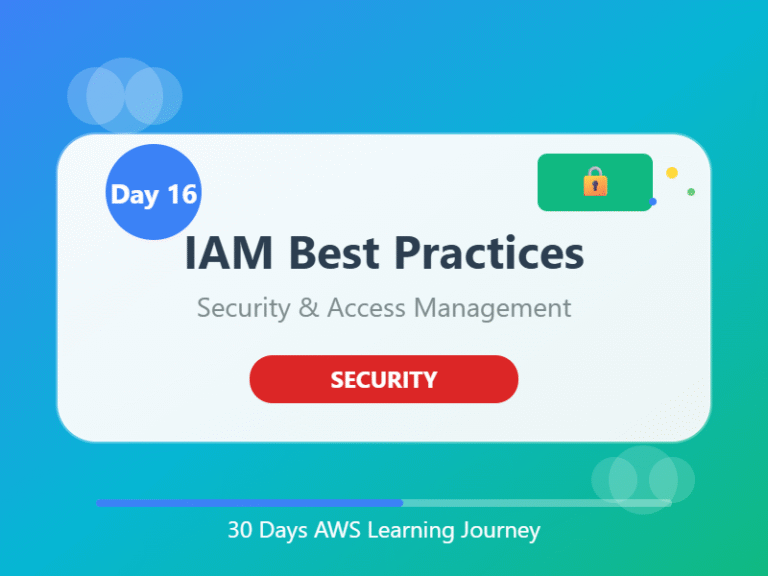🔐 Day 16: IAM Best Practices – Secure Your AWS Like a Pro
Category: Security & Access Control
Goal: Learn how to manage access in AWS the right way using Identity and Access Management (IAM) best practices.
🧠 What You’ll Learn Today:
- What IAM is and why it matters
- Top IAM security tips
- Real-life mistakes to avoid
- How to manage users, roles, and policies safely
🛡️ 1. Quick Recap: What is IAM?
IAM (Identity and Access Management) is the security gatekeeper of AWS.
It lets you:
- Control who can access AWS (users, apps, etc.)
- Decide what they can do (read-only, full access, limited)
- Apply rules using policies
You don’t want everyone to have admin access — that’s where IAM best practices come in.
✅ 2. Top IAM Best Practices (Beginner Friendly)
Here’s what AWS (and real-world experts) recommend:
🔑 1. Enable MFA (Multi-Factor Authentication)
- Add an extra layer of login security
- Especially important for root users and admins
🚫 2. Never Use Root User for Daily Tasks
- The root user has full power over your AWS account
- Use it only to create the first IAM user or make rare changes
- Always log in with an IAM user account after setup
👥 3. Create IAM Users for Everyone
- Don’t share one login
- Each user should have their own credentials
🧾 4. Use Groups to Manage Permissions
- Put users into groups like “Developers”, “Admins”, or “Viewers”
- Apply policies to the group, not each user — makes life easier
📜 5. Use Least Privilege Principle
- Only give access to what the user needs
- For example: If a user only needs to read S3 files, don’t give full S3 access
🎭 6. Use Roles for Applications & Services
- Use IAM Roles to give temporary access to apps, EC2 instances, Lambda functions, etc.
- This avoids hardcoding credentials into your code — much safer!
🧹 7. Rotate Access Keys Regularly
- If you use access keys, rotate them often
- Delete unused ones
🔍 8. Monitor IAM Activity
- Use CloudTrail to see who did what
- Helps detect suspicious activity
⚠️ 3. Common Mistakes Beginners Make
- Giving admin access to everyone ❌
- Hardcoding credentials into code ❌
- Not removing old users ❌
- Ignoring access key rotation ❌
🧠 End of the Day Notes:
Today, you learned that security starts with IAM.
It’s not just about giving access — it’s about giving the right access and protecting your cloud from the inside out.
IAM is like the lock and key system of AWS. If used carelessly, it can lead to major security risks. But if used well — your AWS environment is safe, clean, and easy to manage.
🔁 Navigate the Series:
⬅️ Day 15: AWS Pricing & Calculator – Master Cloud Costs
➡️ Day 17: Route 53 Basics– DNS Made Easy on AWS


